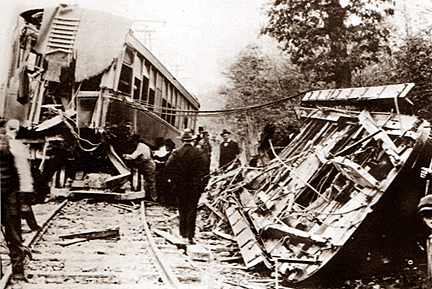|
 Streetcar accidents have ranged all the way
from the terrible to the ridiculous. A streetcar was the only object that
moved along roads that couldn't swerve aside to avoid trouble. Streetcar accidents have ranged all the way
from the terrible to the ridiculous. A streetcar was the only object that
moved along roads that couldn't swerve aside to avoid trouble.
Fatal streetcar accidents commonly fell into two typical
patterns--the rare high-speed derailment or collision, with characteristics
resembling steam-railroad crashes, and the far commoner street-scene
fatality, when some unlucky person became caught unaware on the tracks.
Neither occurred frequently, but both produced some grimly memorable scenes.
A persistent problem for streetcar companies were faked
accidents with their false injury claims. Three favorite kinds included
stumbles on boarding, a pedestrian seemingly sent sprawling by the outward
swing of a car on a curve, or a showy, windmilling fall from a platform or
step. One professional injury claimant had considerable success for a time
by bringing along his own banana peel as a plausible stage setting for his
artistic tumbles.
 A few accident fakers benefited in their trade by old, mis-set fractures or skeletal anomalies. These produced X-rays of internal
problems so pronounced as to loosen up the most tight-fisted juries. The
best weapon that company investigators had against professional victims was
evidence of a series of damage awards in other cities. To keep informed,
they circulated information about fakers between themselves. A few accident fakers benefited in their trade by old, mis-set fractures or skeletal anomalies. These produced X-rays of internal
problems so pronounced as to loosen up the most tight-fisted juries. The
best weapon that company investigators had against professional victims was
evidence of a series of damage awards in other cities. To keep informed,
they circulated information about fakers between themselves.
On New York's Lower East Side some accidents developed
into stylized rituals, like the mating of trumpeter swans. A trolley would
be moving along congested and turbulent Delancey Street when a pushcart
would somehow careen off its side or rear, dumping its contents on the
street. Instantly, loud caterwauls would arise and hundreds of people would
gather to curse the rich and callous traction company. In court later so
many witnesses for the plaintiff would appear, all voluble and eager to
testify about the trolley's reckless speed, that company lawyers found it
virtually impossible to win such suits.
 To cut losses, it became the practice to settle such
claims by equally stylized ritual. Trolley companies would routinely settle
in advance for a flat fee of $25 for a reasonable number of pushcart
accidents a month, properly executed and with witnesses. To cut losses, it became the practice to settle such
claims by equally stylized ritual. Trolley companies would routinely settle
in advance for a flat fee of $25 for a reasonable number of pushcart
accidents a month, properly executed and with witnesses.
Still much inventive effort went into various
pedestrian-protection devices, notably fenders, bedspring-like contrivances
on the front of cars, and life guards, shielding mechanisms in front of the
wheels. They worked, but only after a fashion.
The greatest single step towards safety occurred when
companies replaced the stem-winder hand brake with air brakes.
<
Back to Special Features
Go to next special feature >
|
